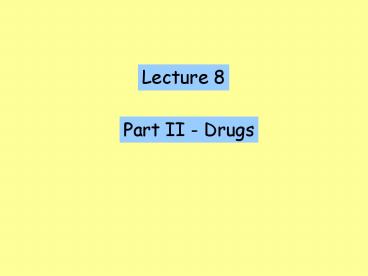Part II Drugs - PowerPoint PPT Presentation
1 / 29
Title:
Part II Drugs
Description:
1976 Dr. Alexander Shulgin (pharmacologist) used as a ... Alkaloid: deadly nightshade, Atropa belladonna. Blocks muscarinic R. Botulinus Toxin ... – PowerPoint PPT presentation
Number of Views:97
Avg rating:3.0/5.0
Title: Part II Drugs
1
Lecture 8
Part II - Drugs
2
alcohol, opiates, nicotine, cocaine marijuana
Because plants have the same Neurotransmitters as
humans - drugs of abuse are derived from plants
or grains DRUGS OF ABUSE
3
3,4-methylenedioxy-N-methamphetamine (MDMA)
Ecstasy
- Stimulant, amphetamine derivative
- Synthetic chemical - oil of the sassafras tree
- Patented (Merck) 1914
- 1976 Dr. Alexander Shulgin (pharmacologist)
used as a - psychotherapeutic tool difficult inter
personal issue - appetite suppressant (1986-DEA)
- Behavioral outcome
- emotional openness open up
- euphoria, stimulation
- reduction of critical and cynical thought
4
- POSITIVE
- extreme mood lift
- increased willingness to communicate
- increase in energy (stimulation)
- feelings of comfort, belonging, and closeness to
others - feelings of love and empathy
- forgiveness
- increased awareness appreciation of music
- increased awareness of senses. (eating,
drinking, smell) - profound life-changing spiritual experiences
- fear dissolution
- sensations bright and intense
- urge to hug and kiss people
5
- NEUTRAL
- appetite loss
- visual distortion
- rapid, involuntary eye jiggling (nystagmus)
- moderately increased heart rate and blood
pressure (increases with dose) - restlessness, nervousness, shivering
- change in body temperature regulation
- strong desire to do or want more when coming down
6
- NEGATIVE (increase with higher doses and
frequent use) - trisma (jaw clenching), tongue and check chewing
bruxia (teeth grinding) - mild to extreme difficulty concentrating ST
memory - muscle tension
- erectile dysfunction and difficulty reaching
orgasm - hyperthermia, dehydration or hyponatremia
- nausea and vomiting
- headaches, dizziness, loss of balance, and
vertigo - post-trip Crash - unpleasantly harsh comedown
from the peak effect - hangover the next day, lasting days to weeks
- mild depression and fatigue for up to a week
- small risk of death Approx. 2 per 100,000 have
extreme negative reactions - resulting in death. (rare)
- Possible neurotoxicity (controversial)
7
MOOD Pleasure 5HT DA temp state
of peace and love with
oneself the world
8
(No Transcript)
9
Serotonergic Projections
Projections to the telencephalon diencephalon
Sleep, mood
Arousal, mood
10
MDNA blocks reuptake of 5HT
11
CON 2wks 7yrs
5-HT immunoreactive axons in monkeys
Note the reduction in axon density
2 weeks after MDMA exposure and the persistent
regional deficits in axon density 7 years after
MDMA exposure
Frontal Parietal Visual
12
13
Survery of ecstasy users (2001) 9.2 - 12th
graders 6.2 - 10th graders 3.5 - 8th
graders College students 2.4 15
14
- Lysergic acid diethylamide (LSD)
- first synthesized from a fungus that grows on
rye - and other grains
- 1938 - Albert Hofmann (Sandoz) produced LSD for
- the first time ? New drug to stimulate
circulation - and respiration flop
- 1943 - Hofmann accidentally ingested (or somehow
- absorbed) a bit of LSD and experienced some of
- the psychedelic effects of this chemical
dizziness, - visual distortions and restlessness
15
A few days later he prepared 0.25 mg (0.05-0.10
mg) of LSD in water and drank it. He again
experienced the mood and thought altering effects
of LSD
Hallucinogens or Psychedelics These drugs can
cause auditory, visual or somatosensory
hallucinations, paranoia or dream-like states
16
- Behavioral Effects
- Feelings of "strangeness"
- Vivid colors
- Hallucinations
- Confusion, panic, psychosis, anxiety
- Emotional reactions like fear, happiness or
sadness - Distortion of the senses and of time and space
- "Flashback - even after months or even a year
- Increases in heart rate and blood pressure
- Chills
- Muscle weakness
17
How LSD works??? not completely known Chemical
structure similar to 5HT Agonist/Antagonist
18
Serotonergic Projections
Projections to the telencephalon diencephalon
Sleep, mood
Arousal RN inhibitory ascending Signalsprotec
ts the brain from sensory OverloadLSD causes
DISINHIBITION ..decreases the firing of 5HT
neurons
19
Mushrooms (..that contain hallucinogens)
20
(No Transcript)
21
Effects on the Nervous System Psilocin Serotonin
ergic agonist ? blocks reuptake of 5HT Binds to
5HT receptors
Muscimol and ibotenic (Amanita muscari) GABA ?
Muscimol GABA agonist
22
- Phencyclidine (PCP) (stimulant, depressant,
analgesic, hallucinogen, dissociative) - developed in 1950s as IV anesthetic
- used in veterinary medicine
- stopped after some people experienced psychotic
rx - dissociative anesthetic out of body experience
- not visual hallucinations but causes changes in
body image - In addition to these distortions of reality, PCP
can cause frightening side effects such as
feelings of terror and confusion.
23
(No Transcript)
24
People do crazy things on PCP!
In a study of 1000 episodes of PCP intoxication,
unpredictable outbursts leading to shootings,
stabbings, grotesque murders self-inflicted
injuries occurred in 35 of the cases 32 of the
users displayed bizarre behaviors ?wandering
about nude in public ?lying down in the middle
of a busy street ?driving 10 mph on the freeway
25
Effects of PCP on the Brain (multiple
NT) inhibits the reuptake of dopamine,
norepinephrine and serotonin inhibits
glutamate by blocking receptors NMDA
(N-methyl-D-aspartate) Some types of opioid
receptors in the brain are also affected by PCP
26
Many natural substances affect the functioning of
synapses plants Many animals release chemicals
that affect functioning of synapses -
snakes spiders
27
Natural Cholinergic Agonist and Antagonists
ACh
Addiction-DA
salivation , sweating, tears
swelling, Muscles rigid, abdomen back
mydriatic, HR spasmolytic, memory
Dbl. Vision swallowing, Res. suffocation
Paralysis, Respir. fail
Paralysis
28
(No Transcript)
29
(No Transcript)































